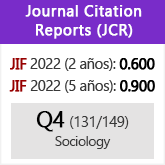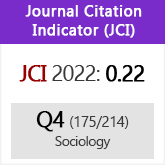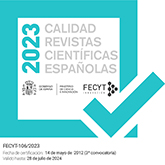Concurrencia de comportamientos de riesgo entre adolescentes españoles
DOI:
https://doi.org/10.3989/ris.2011.03.18Palabras clave:
Adolescentes, Comportamientos de riesgo, Perfiles de riesgo, EspañaResumen
Este trabajo examina la concurrencia de comportamientos de riesgo en adolescentes españoles. Los comportamientos analizados fueron la actividad sexual, el consumo de alcohol y otras drogas, conductas violentas y comportamientos en la conducción de ciclomotores o motocicletas. La muestra incluye 4.091 adolescentes de 13 a 18 años, perteneciente a educación secundaria obligatoria. Los resultados obtenidos muestran cuatro perfiles de riesgo, siendo uno de ellos el perfil de más alto riesgo y concurrencia de comportamientos arriesgados. Este grupo supone el 13% en el que destacan las conductas de consumo de drogas lícitas, conducir bajo los efectos de droga y otras conductas realizadas bajo los efectos del alcohol. Se encuentran diferencias entre estos perfiles y las características sociodemográficas como el sexo, el curso, la percepción sobre la economía familiar y la etnicidad. Se discuten los resultados obtenidos y se ofrece algunas sugerencias para la prevención.
Descargas
Citas
Alhájeme, A. and M. Martínez. 2004. “Estructura de edades, escolarización y tamaño de la población gitana asentada en España.” Revista Española de Investigaciones Sociológicas 106:161-174.
Anderson, K.G., S.F. Tapert, I. Moadab, T.J. Crowley and S. A. Brown. 2007. “Personality risk profile for conduct disorder and substance use disorders in youth.” Addictive Behaviors 32:2377-2382. http://dx.doi.org/10.1016/j.addbeh.2007.02.006 PMid :17408870
Arnett, J.J. 1992. “Reckless behaviour in adolescence: a developmental perspective.” Developmental Review 12:339-373. http://dx.doi.org/10.1016/0273-2297(92)90013-R
Arnett, J.J. and L. Arnett. 1994. “Socialization and risk behavior in two countries: Denmark and United States.” Youth and Society 26:3-22. http://dx.doi.org/10.1177/0044118X94026001001
Baskin-Sommers, A. and I. Sommers. 2006. “The co-occurrence of substance use and high-risk behaviors.” Journal of Adolescent Health 38:609-611. http://dx.doi.org/10.1016/j.jadohealth.2005.07.010 PMid :16635777
Brener, N.D., and J.L. Collins. 1998. “Co-Occurrence of Health-Risk Behaviors Among Adolescents in the United States.” Journal of Adolescent Health 22:209-213. http://dx.doi.org/10.1016/S1054-139X(97)00161-4
Brindis, C., Wolfe, A.L., Mccarter, V., Ball, S. and S. Starbuck-Morales. 1995. “The Associations Between Immigrant Status and Risk-Behavior Patterns in Latino Adolescents.” Journal of Adolescence Health 17:99-105. http://dx.doi.org/10.1016/1054-139X(94)00101-J
Byrnes J., Miller, D.C. and W. Schafer. 1999. “Gender differences in risk taking: A Meta-Analysis.” Psychological Bulletin 125:367-383. http://dx.doi.org/10.1037/0033-2909.125.3.367
Carrasco, A.M. 2002. “Estilo de vida, consumo de alcohol y factores psicosociales asociados: un estudio en adolescentes.” Revista de Psicología Social Aplicada 12:49-78.
Coleman, J. and A. Hagell. 2007. Adolescence, risk and resilience. Against the odds. Chichester West Sussex: John Wiley and Sons Ltd.
Cooper, M.L., V.B. Agocha and M.S. Sheldon. 2000. “A Motivational Perspective on Risky Behaviors: the Role of Personality and Affect Regulatory Processes.” Journal of Personality 68:1059-1088. http://dx.doi.org/10.1111/1467-6494.00126 PMid :11130732
Defensor del Pueblo. 2007 (Spanish Ombudsman). Violencia escolar: el maltrato entre iguales en la educación secundaria obligatoria. Madrid.
D.G.T. (National Traffic Administration of Spain). 2007. Anuario estadístico de accidentes 2006. Dirección General de Tráfico. Madrid. Ministerio del Interior. España.
Dolcini, M.M., L.D. Cohn, N.E. Adler, S.G. Millstein, C.E. Irwin, S.M. Kegeles and G.C. Stone. 1989. “Adolescent egocentrism and feelings of invulnerability.” The Journal of Early Adolescence 9:409-418. http://dx.doi.org/10.1177/0272431689094003
Dorius G., T. Heaton, and P. Steffen. 1993. “Adolescent life events and their association with the onset of sexual intercourse.” Youth and Society 25:3-23. http://dx.doi.org/10.1177/0044118X93025001001
Dworkin, J. 2005. “Risk Taking as Developmentally Appropriate Experimentation for College Students.” Journal of Adolescent Research 20:219-241. http://dx.doi.org/10.1177/0743558404273073
Eklund, J.M. and B.A. Klinteberg. 2005. “Personality Characteristics as Risk Indications of Alcohol Use and Violent Behavior in Male and Female Adolescents.” Journal of Individual Differences 26:63-73. http://dx.doi.org/10.1027/1614-0001.26.2.63
Essau, C.A. 2004. “Risk-taking behaviour among German adolescents.” Journal of Youth Studies. 7:499-512. http://dx.doi.org/10.1080/1367626042000315248
Fischhoff, B., E. Nightingale and J. Iannotta (ed). 2001. Adolescent risk and vulnerability. Concepts and measurement. Washington, D.C.: National Academy Press.
Flay, B.R. 2003. “Positive Youth development is necessary and possible.” Pp.347-355 in Reducing adolescent risk. Toward an integrated approach edited by Romer D. Thousand Oaks, CA: Sage Publications.
Flisher, A.J., R.A. Kramer, C.W. Hoven, R.A. King, H.R. Bird, M. Davies, M.S. Gould, S. Greenwald, B.B. Lahey, D.A., Regier, M. Schwab-Stone and D. Shaffer. 2000. “Risk Behavior in a Community Sample of Children and Adolescents.” Journal of the American Academy of Child and Adolescent Psychiatry 39:881-887. http://dx.doi.org/10.1097/00004583-200007000-00017
Gamella, J.F. 1997. “Heroína en España (1977-1996). Balance de una crisis de drogas.” Claves de Razón Práctica 72:20-30.
Gamella, J.F. 2004. “Exclusión social y diferencia étnica: el caso de los gitanos.” Pp. 603-647 in Tendencias en desigualdad y exclusión social, edited by Tezanos F. Madrid: Sistema.
García, F. and E. Gracia. 2009. “Is always authoritative the optimum parenting style? Evidence from Spanish families.” Adolescence 44:101-131. PMid :19435170
Gibbons, J.L., R. Bradford and D.A. Stiles 1989. “Madrid adolescents express an interest in gender roles and work possibilities.” The Journal of Early Adolescence 9:125-141. http://dx.doi.org/10.1177/0272431689091010
Gittelsonhn, J., K. Roche, C.H. Alexander and P. Tassler. 2001. “The social context of smoking among African-American and white adolescents in Baltimore City.” Ethnicity and Health 6:211-225. http://dx.doi.org/10.1080/13557850120078134
Graham, P. 2004. The end of adolescence. Oxford: Oxford University Press.
Guilamo-Ramos, V., H. A. Litardo and J. Jaccard. 2005. “Prevention Programs for Reducing Adolescent Problem Behaviors: Implications of the Co-Occurrence of Problem Behaviors in Adolescence.” Journal of Adolescent Health 36:82-86. http://dx.doi.org/10.1016/j.jadohealth.2003.12.013 PMid :15661605
Hazard, B.P. and C.F. Lee. 1999. “Understanding youth’s health-compromising behaviors in Germany.” Youth and Society 30:348-366. http://dx.doi.org/10.1177/0044118X99030003004
Hart, G. 1999. “Risk and Health: challenges and opportunity.” Health, Risk and Society 1:7-10. http://dx.doi.org/10.1080/13698579908407003
Hidalgo, I., Garrido, G. and M. Hernandez. 2000. “Health Status and Risk Behavior of Adolescents in the North of Madrid, Spain.” Journal of Adolescent Health 27:351-360. http://dx.doi.org/10.1016/S1054-139X(00)00100-2
INE (National Statistics Institute) 2008. Estadísticas 2008. National Statistics Institute of Spain. (http://www.ine.es/jaxi/menu.do?type=pcaxisandpath=%2Ft20%2Fe245andfile=inebaseandL=0)(2-12-2008).
Ingersoll, G.M. and D.P. Orr. 1989. “Behavioral and emotional risk in early adolescents.” The Journal of Early Adolescence 9:396-408. http://dx.doi.org/10.1177/0272431689094002
INJUVE (Spanish Youth Institute) 2004. Juventud en cifras, Relaciones de Pareja. Informe de la Juventud de España. Madrid: Injuve. http:/www.injuve.mtas.es/injuve/contenidos.downloadatt.action?id=532167465 (15-04-08).
Instituto de la Mujer. 2008. Interrupción voluntaria del embarazo en adolescentes. (http://www.migualdad.es/mujer/mujeres/cifras/tablas/W83-84.XLS) (12-12-2008). Madrid: Instituto de la Mujer.
Jessor, R. 1991. “Risk behaviour in adolescence: A Psychosocial framework for understanding and action.” Journal of Adolescent Health 1:597-605. http://dx.doi.org/10.1016/1054-139X(91)90007-K
Kagan, J. 1991. “Etiologies of Adolescents at risk.” Journal of Adolescent Health 12:591-596. http://dx.doi.org/10.1016/1054-139X(91)90006-J
Kandel, D. and K. Yamaguchi. 1993. “From beer to crack: developmental patterns of drugs involvement.” Am J Public Health 83:851-5. http://dx.doi.org/10.2105/AJPH.83.6.851 PMid :8498623 PMCid:1694748
Kobayashi, E., S. Sharp and H.G. Grasmick. 2008. “Gender and deviance: a comparison of college students in Japan and United States.” Deviant Behavior 29:413-439. http://dx.doi.org/10.1080/01900690701598010
Lightfoot, C. 1997. The Culture of Adolescent Risk-Taking. New York: The Guilford Press.
Maggs, J.L., D.M. Almeida and N.L. Galambos. 1995. “Risky Business. The paradoxical meaning of problem behaviour for young adolescents.” The Journal of Early Adolescence 15:344-362. http://dx.doi.org/10.1177/0272431695015003004
Marsiglia, F., S. Killis, M.A. Luengo, T. Nieri and P. Villar. 2008. “Immigrant advantage? Substance use among Latin American immigrant and native-born youth in Spain.” Ethnicity and Health 13:149-170. http://dx.doi.org/10.1080/13557850701830356
Martín, E. and J.F. Gamella. 2005. “Marriage practices and differentiation: the case of Spanish Gypsies (1870-2000).” The History of the Family 10:45-63. http://dx.doi.org/10.1016/j.hisfam.2004.03.004
Millstein, S.G. and B.L. Halpern-Felsher. 2001. “Perceptions of risk and vulnerability” Pp.15-49 in Adolescent risk and vulnerability. Concepts and measurement edited by Fischhoff, B., Nightingale, E. and Iannotta J. Washington: National Academy Press.
N.P.D (National Plan on Drugs). 2007. Informe de la encuesta estatal sobre uso de drogas en estudiantes de enseñanzas secundarias (ESTUDES) 2006-2007. Ministerio de Sanidad y Consumo. Secretaria General de Sanidad. Delegación del Gobierno para el Plan Nacional sobre Drogas. Madrid.
Oñederra, J.A., P. Martinez and E. Ubieta 2005. El maltrato entre iguales, bullying en Euskadi. Educación Secundaria. Vitoria-Gasteiz: Gobierno Vasco.
Rhodes, T. 1997. “Risk Theory in Epidemic Times: Sex, Drugs and the Social Organisation of ‘Risk Behaviour’.” Sociology of Health and Illness 19:208-227. http://dx.doi.org/10.1111/1467-9566.ep10934410
Rodríguez, E., J. C. Ballesteros, I. Megías and M.A. Rodríguez. 2008. La lectura juvenil de los riesgos de las drogas: del estereotipo a la complejidad. Madrid: Fundación de Ayuda contra la Drogadicción.
Romo, N. 2001. Mujeres y drogas de sintesis. Genero y riesgo en la cultura del baile. Donostia: Tercera Prensa-Hirugarren Prentsa S.L.
Spear, H.J. and P. A. Kulbok. 2001. “Adolescent Health behaviors and related factors: A review.” Public Health Nursing 18:82-93. http://dx.doi.org/10.1046/j.1525-1446.2001.00082.x PMid :11285102
Weden, M.M. and L. S. Zabin. 2005. “Gender and Ethnic Differences in the Co-Occurrence of Adolescent Risk Behaviors.” Ethnicity and Health 10:213-234. http://dx.doi.org/10.1080/13557850500115744
Zweig, J.M., L. D. Lindberg and K.A. Mcginley. 2001. “Adolescent Health Risk Profiles: the Co-Occurrenceof Health Risks Among Females and Males.” Journal of Youth and Adolescence 30:707-728. http://dx.doi.org/10.1023/A:1012281628792
Zwieg, J.M., S.D. Phillips and L.D. Lindberg. 2002. “Predicting Adolescent Profiles of Risk: Looking Beyond Demographics.” Journal of Adolescent Health 31:343-353. http://dx.doi.org/10.1016/S1054-139X(02)00371-3
Descargas
Publicado
Cómo citar
Número
Sección
Licencia
Derechos de autor 2012 Consejo Superior de Investigaciones Científicas (CSIC)

Esta obra está bajo una licencia internacional Creative Commons Atribución 4.0.
© CSIC. Los originales publicados en las ediciones impresa y electrónica de esta Revista son propiedad del Consejo Superior de Investigaciones Científicas, siendo necesario citar la procedencia en cualquier reproducción parcial o total.Salvo indicación contraria, todos los contenidos de la edición electrónica se distribuyen bajo una licencia de uso y distribución “Creative Commons Reconocimiento 4.0 Internacional ” (CC BY 4.0). Puede consultar desde aquí la versión informativa y el texto legal de la licencia. Esta circunstancia ha de hacerse constar expresamente de esta forma cuando sea necesario.
No se autoriza el depósito en repositorios, páginas web personales o similares de cualquier otra versión distinta a la publicada por el editor.

















